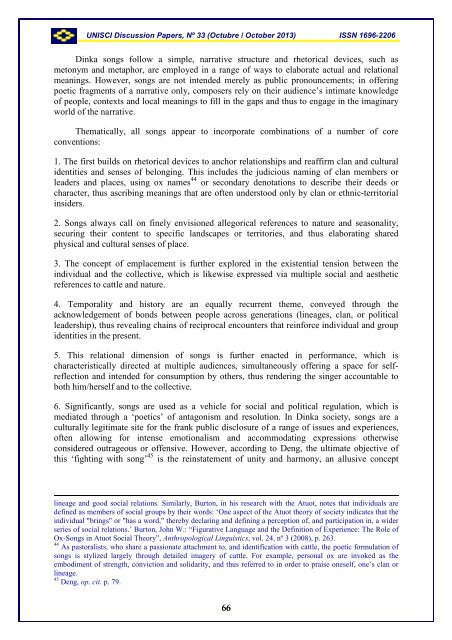UNISCI - Universidad Complutense de Madrid
UNISCI - Universidad Complutense de Madrid
UNISCI - Universidad Complutense de Madrid
Create successful ePaper yourself
Turn your PDF publications into a flip-book with our unique Google optimized e-Paper software.
<strong>UNISCI</strong> Discussion Papers, Nº 33 (Octubre / October 2013) ISSN 1696-2206Dinka songs follow a simple, narrative structure and rhetorical <strong>de</strong>vices, such asmetonym and metaphor, are employed in a range of ways to elaborate actual and relationalmeanings. However, songs are not inten<strong>de</strong>d merely as public pronouncements; in offeringpoetic fragments of a narrative only, composers rely on their audience’s intimate knowledgeof people, contexts and local meanings to fill in the gaps and thus to engage in the imaginaryworld of the narrative.Thematically, all songs appear to incorporate combinations of a number of coreconventions:1. The first builds on rhetorical <strong>de</strong>vices to anchor relationships and reaffirm clan and culturali<strong>de</strong>ntities and senses of belonging. This inclu<strong>de</strong>s the judicious naming of clan members orlea<strong>de</strong>rs and places, using ox names 44 or secondary <strong>de</strong>notations to <strong>de</strong>scribe their <strong>de</strong>eds orcharacter, thus ascribing meanings that are often un<strong>de</strong>rstood only by clan or ethnic-territorialinsi<strong>de</strong>rs.2. Songs always call on finely envisioned allegorical references to nature and seasonality,securing their content to specific landscapes or territories, and thus elaborating sharedphysical and cultural senses of place.3. The concept of emplacement is further explored in the existential tension between theindividual and the collective, which is likewise expressed via multiple social and aestheticreferences to cattle and nature.4. Temporality and history are an equally recurrent theme, conveyed through theacknowledgement of bonds between people across generations (lineages, clan, or politicallea<strong>de</strong>rship), thus revealing chains of reciprocal encounters that reinforce individual and groupi<strong>de</strong>ntities in the present.5. This relational dimension of songs is further enacted in performance, which ischaracteristically directed at multiple audiences, simultaneously offering a space for selfreflectionand inten<strong>de</strong>d for consumption by others, thus ren<strong>de</strong>ring the singer accountable toboth him/herself and to the collective.6. Significantly, songs are used as a vehicle for social and political regulation, which ismediated through a ‘poetics’ of antagonism and resolution. In Dinka society, songs are aculturally legitimate site for the frank public disclosure of a range of issues and experiences,often allowing for intense emotionalism and accommodating expressions otherwiseconsi<strong>de</strong>red outrageous or offensive. However, according to Deng, the ultimate objective ofthis ‘fighting with song’ 45 is the reinstatement of unity and harmony, an allusive conceptlineage and good social relations. Similarly, Burton, in his research with the Atuot, notes that individuals are<strong>de</strong>fined as members of social groups by their words: ‘One aspect of the Atuot theory of society indicates that theindividual "brings" or "has a word," thereby <strong>de</strong>claring and <strong>de</strong>fining a perception of, and participation in, a wi<strong>de</strong>rseries of social relations.’ Burton, John W.: “Figurative Language and the Definition of Experience: The Role ofOx-Songs in Atuot Social Theory”, Anthropological Linguistics, vol. 24, nº 3 (2008), p. 263.44 As pastoralists, who share a passionate attachment to, and i<strong>de</strong>ntification with cattle, the poetic formulation ofsongs is stylized largely through <strong>de</strong>tailed imagery of cattle. For example, personal ox are invoked as theembodiment of strength, conviction and solidarity, and thus referred to in or<strong>de</strong>r to praise oneself, one’s clan orlineage.45 Deng, op. cit. p. 79.66
















